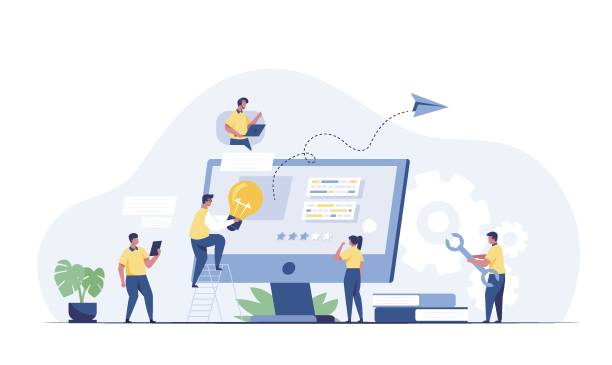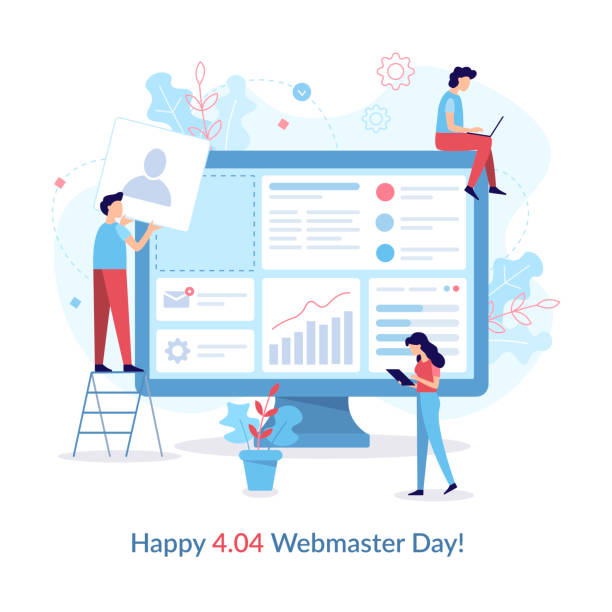An Introduction to the Importance of Secure Website Design

In today’s digital world, where a significant portion of daily life and businesses has shifted online, the topic of #website_security has gained unprecedented importance.
#Secure_website_design is not merely an additional feature, but a vital necessity for any organization or individual intending to have an effective and reliable online presence.
Disregarding this issue can lead to catastrophic consequences such as the loss of sensitive data, violation of user privacy, damage to business reputation, and even hefty financial penalties.
This section demonstrates why security should be considered from the very first steps of website design and development, and not as an afterthought.
Indeed, a secure website design not only protects your information but also assures users that they can use your services with peace of mind.
Discussing common challenges and threats in cyberspace also greatly helps to clarify the necessity of this topic.
The aim of this educational and explanatory article is to enhance your understanding of the various aspects of secure website design.
Does your current website build the trust that potential customers should have in your business? If the answer is no, it’s time to have your professional and impactful corporate website with RasaWeb.
✅ Fully customized design tailored to your brand identity
✅ Increased lead generation and business credibility in the eyes of customers⚡ Contact us for a free consultation!
Common Challenges and Threats in Web Security

The web world is full of various threats that can jeopardize the stability and security of websites.
Identifying and understanding these challenges is the first step towards a secure and effective website design.
One of the most common attacks is #SQL_Injection, where an attacker attempts to access or modify database information by injecting malicious SQL code into program inputs.
#Cross-Site_Scripting (XSS) attacks also allow attackers to inject malicious code into web pages and steal user information.
#DDoS (Distributed Denial of Service) attacks flood the server with traffic, taking it offline and causing damage to businesses.
#Malware and #viruses are also always serious threats that can spread through vulnerable websites.
#Phishing is a type of social engineering that deceives users into revealing their confidential information by impersonating trusted entities.
Furthermore, weaknesses in server configuration, failure to update software, and poor password management also provide avenues for attackers to infiltrate.
This section analytically and explanatorily examines these threats and demonstrates how to adopt a proactive approach to secure website design by understanding them.
Fundamental Principles in Implementing Secure Website Design

To achieve a #secure_and_resilient_website_design, adherence to fundamental information security principles is essential.
These principles include a set of specialized measures and approaches that must be applied throughout all stages of website development and maintenance.
Input Validation is one of the most important; ensuring that all user-supplied input data is clean and safe and does not contain malicious code.
Furthermore, the use of Prepared Statements and ORMs in database interactions can effectively prevent SQL Injection attacks.
The principle of #Least_Privilege means that every user or system should only have access to the minimum resources and permissions required to perform their tasks.
#Regular_updates of all software, plugins, and frameworks used are also crucial to address discovered vulnerabilities.
#Proper_error_management is also important; displaying general error information instead of technical details that could be useful to attackers.
Finally, Secure Coding from the project’s inception is essential to prevent the creation of security weaknesses.
This section specialistically and instructively delves into these principles to provide practical guidance for implementing a secure website.
| Vulnerability | Brief Description | Main Prevention Method |
|---|---|---|
| SQL Injection | Injecting malicious SQL code to access the database. | Use of Prepared Statements and ORM. |
| XSS (Cross-Site Scripting) | Injecting malicious client-side scripts. | Input validation and Output escaping. |
| Broken Authentication | Weaknesses in authentication mechanisms. | Enforce strong password policies, MFA. |
| Insecure Deserialization | Ability to exploit the object reconstruction process. | Only deserialize trusted data. |
| Security Misconfiguration | Weak security configurations of the server or application. | Remove unnecessary features, secure configuration. |
The Role of SSL/TLS Certificates in Website Security

SSL/TLS certificates play a pivotal role in secure website design.
These certificates provide a protocol for encrypting communication between the user’s browser and the website server, ensuring that all transmitted data (such as login information, credit card details, and personal information) is securely and undetectably exchanged.
This technology, which causes the website address to change from HTTP to HTTPS, prevents information theft during transit.
There are various types of SSL/TLS certificates, including Domain Validation (DV), which only validates the domain; Organization Validation (OV), which also verifies the organization’s identity; and Extended Validation (EV), which provides the highest level of assurance and displays the company name in the address bar.
Using HTTPS not only enhances security but also has a positive impact on #SEO rankings and builds #user_trust.
Browsers mark websites without HTTPS as insecure, which can be discouraging for visitors.
This section specialistically and instructively highlights the importance of these certificates in modern and secure web design.
Are you tired of your e-commerce site having visitors but no sales? RasaWeb solves your main problem with professional e-commerce website designs!
✅ Significant sales increase with targeted design
✅ Flawless user experience for your customers
⚡ Get a free consultation!
Secure Coding and Vulnerability Prevention

Secure Coding is the backbone of a secure website design.
This approach means writing code that is designed from the outset to withstand cyberattacks, rather than merely adding security patches after project completion.
Among the most important aspects of secure coding is rigorous validation of inputs and outputs to prevent the injection of malicious code or the display of sensitive information.
Furthermore, the use of standard and up-to-date functions and libraries that are themselves security-tested is strongly recommended, instead of writing custom functions that may have weaknesses.
Proper error and logging message management is also crucial; error messages should not reveal sensitive information that attackers could exploit.
Additionally, Session Management should ensure that session IDs are randomly generated, complex, and have a limited lifespan.
Using #OWASP_Top_10 as a comprehensive guide for identifying and mitigating the most common web vulnerabilities is a fundamental step in secure coding.
Developers must continuously update their knowledge in web security to provide websites with high #web_protection.
This section specialistically and instructively addresses the importance of these principles in the coding stages.
Password Management and Two-Factor Authentication

Strong password management and the use of #Two-Factor_Authentication (MFA) are among the most fundamental layers of a secure website design.
Many successful cyberattacks originate from weak or stolen passwords.
Websites should encourage users to use complex passwords (including uppercase and lowercase letters, numbers, and symbols) and require them to periodically change their passwords.
Storing passwords as hashed values with #Salt is of paramount importance, such that even if the database is breached, passwords cannot be recovered.
However, a strong password alone is not enough.
#MFA provides an additional layer of security; even if a user’s password falls into the attacker’s hands, logging into the system will require a second factor, such as a code sent to the phone or authentication via an authenticator app.
This section guidance and instructionally discusses how to strengthen password policies and implement various types of MFA (such as TOTP, SMS, Push Notifications).
Encouraging users to use a #Password_Manager is also an important step to enhance individual and overall site security.
Secure website design should implement these mechanisms in a user-friendly manner so as not to disrupt the user experience.
Backup and Data Recovery in Secure Website Design

Regular backup and planning for #data_recovery are vital components of a secure and stable website design.
Even with the best security practices, the possibility of unexpected incidents such as successful cyberattacks, hardware failures, human error, or natural disasters always exists.
In such situations, having up-to-date and recoverable backup copies can make the difference between permanent data loss and rapid service restoration.
Various backup methods include Full Backup, Incremental Backup, and Differential Backup, each with its own advantages and disadvantages.
It is important that backups are stored in secure, off-site locations to prevent their loss in case of a physical incident.
Furthermore, periodic testing of the data recovery process is essential to ensure the integrity and effectiveness of the backup copies.
This section guidance and specialistically discusses effective data backup and recovery strategies.
Attention to these points is an integral part of the overall secure website design strategy.
| Backup Type | Advantages | Disadvantages | Use Cases |
|---|---|---|---|
| Full | Simplest recovery, includes all data | Time-consuming, large space, high bandwidth | Initial backup, weekly/monthly backup |
| Incremental | Least time and space required for backup | Time-consuming recovery, requires full backup and all incrementals | Daily backup for highly changing data |
| Differential | Faster recovery than incremental, moderate space | More space than incremental, more time than full | Daily backup for moderately changing data |
The Future of Secure Website Design and Artificial Intelligence

The future of secure website design is closely intertwined with advancements in Artificial Intelligence (AI) and Machine Learning (ML).
While attackers use AI to automate more sophisticated attacks, defenders can also leverage these same technologies for identifying and preventing new threats.
AI-powered security systems can detect anomalous patterns in network traffic, identify suspicious user activities, and even contain unknown malware before it causes significant damage.
Technologies such as #Blockchain also hold significant potential for enhancing data and identity security by providing a distributed and immutable ledger.
These capabilities raise #questionable_content regarding the future of cyber threats and defenses: Will AI ultimately lead to an endless arms race or can it drastically elevate the overall level of security? Research in quantum-based cybersecurity is also underway, which could render current encryptions obsolete.
This section newswise and analytically addresses these developments and provides a glimpse into future challenges and opportunities in secure site design and maintenance.
Investing in these technologies will be essential for maintaining the #sustainable_security of a website.
Are you tired of your e-commerce site having visitors but no sales? RasaWeb solves your main problem with professional e-commerce website designs!
✅ Significant sales increase with targeted design
✅ Flawless user experience for your customers
⚡ Get a free consultation!
Choosing the Best Web Host for Enhanced Security

Choosing a suitable #Web_Host is one of the key decisions towards #secure_website_design.
Many website vulnerabilities originate from the weak security infrastructures of hosting providers.
A reputable web host committed to security should have multiple layers of defense, including strong firewalls, Intrusion Detection and Prevention Systems (IDS/IPS), and protection against DDoS attacks.
Furthermore, ensuring that your host regularly updates its servers and uses stable and secure versions of necessary software (such as PHP, Apache/Nginx, MySQL) is crucial.
The capability for automatic and regular backups, provision of free or affordable SSL/TLS certificates, and strong and fast technical support in emergencies are also important factors.
Before making a final choice, be sure to check user reviews and the hosting company’s reputation, and be informed about their security standards.
This section guidance and specialistically discusses the criteria for choosing a secure web host, so users can make the best decision in building and maintaining a secure website design.
Final Checklist for Ensuring Website Security

To ensure your website is secured in the best possible way, a comprehensive security checklist can be very useful.
This list includes measures that should be reviewed periodically and after any major change to the website, to ensure the stability of a #secure_website_design.
Firstly, regular penetration testing and vulnerability assessment are crucial for identifying potential weaknesses.
Secondly, ensuring that all software, plugins, and frameworks are up-to-date.
Thirdly, implementing and maintaining Content Security Policy (CSP) and other HTTP security headers to mitigate client-side attacks.
Fourthly, continuous monitoring of server and application logs to detect suspicious activities.
Fifthly, having an #Incident_Response_Plan that specifies how to react in case of an attack.
Sixthly, continuous training for the website development and management team on cybersecurity best practices.
This section guidance and instructionally provides a roadmap for maintaining your website’s security and helps you always have a secure and reliable website design.
This process is an ongoing commitment, not a one-time action.
Frequently Asked Questions
| Row | Question | Answer |
|---|---|---|
| 1 | What is secure website design? | Secure website design is a process where websites are built with security measures in mind from the initial development stages to protect against cyberattacks, unauthorized access, and data loss. |
| 2 | Why is secure website design important? | Website security is crucial for maintaining user trust, protecting sensitive information (personal and financial), preventing damage to brand reputation, and complying with privacy and security regulations (such as GDPR). A security breach can lead to financial and legal damages. |
| 3 | What are the most common cyberattacks a website faces? | Some of the most common attacks include SQL Injection, Cross-Site Scripting (XSS), Distributed Denial of Service (DDoS), Brute Force, and credential-based attacks (Credential Stuffing). |
| 4 | What is SQL Injection and how to prevent it? | SQL Injection is a type of attack where an attacker attempts to manipulate the database or extract information by injecting malicious SQL code into site inputs. To prevent it, one should use Prepared Statements/Parameterized Queries, ORM (Object-Relational Mapping), and rigorous input validation. |
| 5 | What is Cross-Site Scripting (XSS)? | XSS is a type of attack where an attacker injects malicious scripts (usually JavaScript) into web pages that are then executed by other users’ browsers. This can lead to the theft of cookies, session information, or alteration of the website’s appearance. |
| 6 | How can Brute Force attacks on login pages be prevented? | To prevent Brute Force attacks, one should use CAPTCHA, limit the number of failed login attempts (Account Lockout), Two-Factor Authentication (2FA), and utilize complex and long passwords. |
| 7 | What is the role of HTTPS in website security? | HTTPS encrypts the communication between the user’s browser and the website server using SSL/TLS. This prevents eavesdropping, tampering, or forgery of information during transmission and increases user trust. |
| 8 | What is the importance of Input Validation in security? | Input validation is the process of checking and sanitizing data entered by the user. This prevents the injection of malicious code, XSS attacks, SQL Injection, and other vulnerabilities, ensuring that data conforms to the expected format. |
| 9 | Why are regular updates of website systems and software essential? | Regular updates of the operating system, CMS (like WordPress), plugins, themes, and libraries used address known security vulnerabilities. Hackers often exploit weaknesses in outdated software for infiltration. |
| 10 | What role does regular backup play in secure website design? | Regular and tested backups of website data (database and files) are a vital layer of defense against data loss due to cyberattacks, human errors, or hardware failures. This enables rapid website recovery in case of a disaster. |
And other services of RasaWeb Advertising Agency in the field of advertising
Smart Direct Marketing: A fast and efficient solution to increase click-through rates with a focus on precise audience targeting.
Smart Content Strategy: A fast and efficient solution for digital branding with a focus on intelligent data analysis.
Smart SEO: An innovative platform for improving online growth with intelligent data analysis.
Smart Conversion Rate Optimization: A dedicated service for enhancing user engagement based on Google Ads management.
Smart Advertising Campaign: A fast and efficient solution to improve SEO ranking with a focus on precise audience targeting.
And over a hundred other services in the field of internet advertising, advertising consultation, and organizational solutions
Internet Advertising | Advertising Strategy | Advertorial
Resources
Source 1
Source 2
Source 3
Source 4
? To soar in the digital space and reach more audiences, RasaWeb Afarin Digital Marketing Agency paves the way for your business’s success by offering services such as responsive website design and professional optimization.
📍 Tehran, Mirdamad Street, next to Bank Markazi, Southern Kazeroon Alley, Ramin Alley, No. 6



